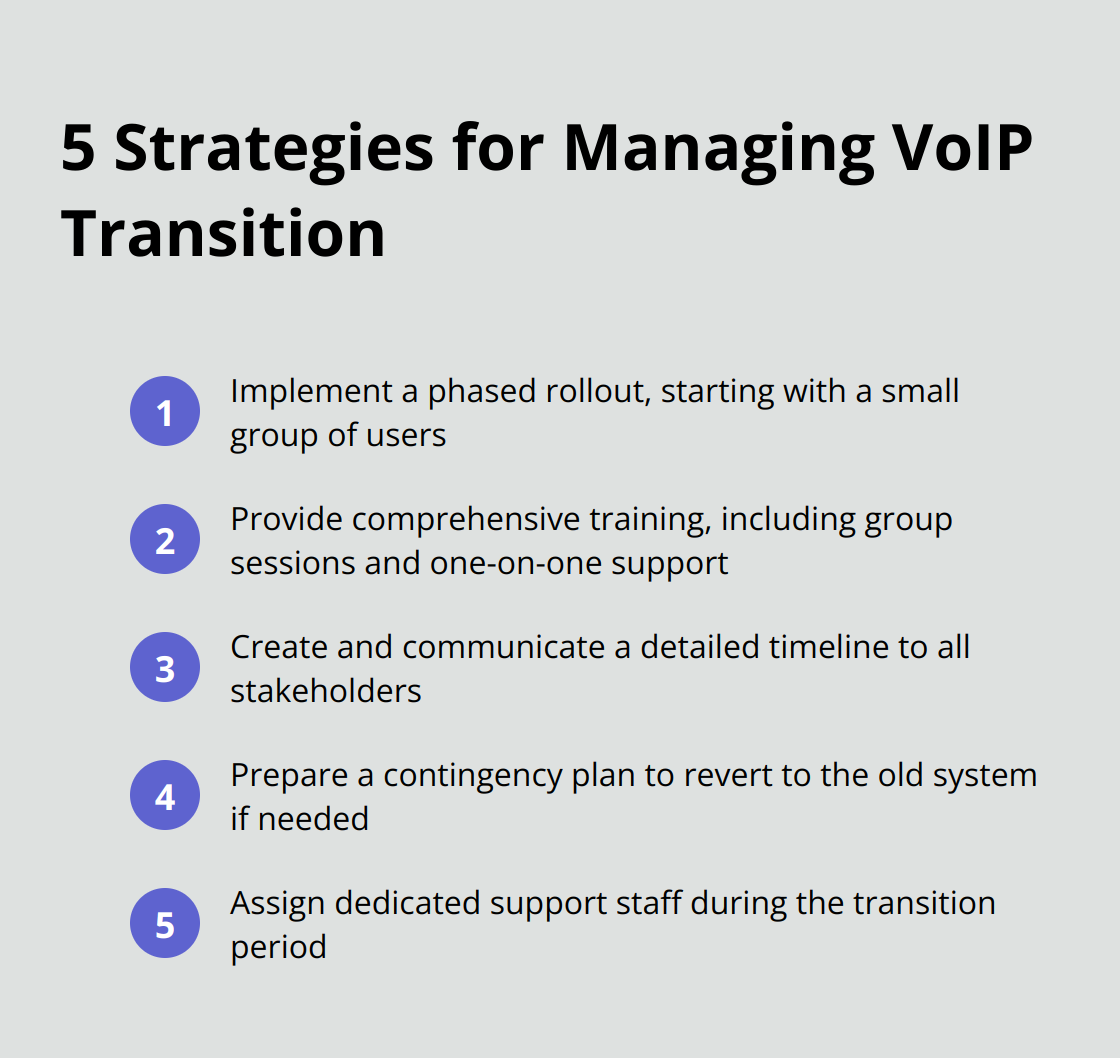VoIP migration is one of the most impactful yet misunderstood transitions modern businesses face. While the move from traditional phone systems to internet-based communication unlocks major gains in flexibility, cost savings, and scalability, it also comes with unexpected complexity.
At UCaaS Review, we’ve seen organizations of all sizes wrestle with planning gaps, technical hurdles, and change management challenges. In this guide, we’ll break down what makes VoIP migration successful and how to avoid the common pitfalls that can stall progress before it begins.
Why Businesses Are Embracing VoIP
The Limitations of Traditional Phone Systems
Traditional phone systems, once the backbone of business communication, now fail to meet the demands. These systems rely heavily on expensive on-premises hardware that requires regular maintenance and upgrades. They lack the scalability needed for growing businesses and often demand significant investments to add new lines or features.
Furthermore, traditional systems are geographically constrained, making it difficult for businesses to expand or support remote work. A recent survey reveals that among those with remote-capable jobs, 27% are fully remote, 53% have a hybrid schedule, and 21% work on-site, underscoring the need for more flexible communication solutions that can support distributed teams.
VoIP: A Revolution in Business Communication
Voice over Internet Protocol (VoIP) technology addresses these limitations by using internet connectivity to transmit voice calls. This shift from traditional circuit-switched telephony to packet-switched networks brings numerous benefits for businesses.
One of the most significant advantages is the unification of communications. VoIP systems integrate with other business tools (such as CRM software, email, and video conferencing platforms). This integration streamlines workflows and enhances productivity. A study found that companies adopting unified communications reported 25% higher productivity from flexible working environments aided with good communication.
The Financial Advantages of VoIP
The cost savings associated with VoIP are substantial. Businesses can save up to 75% on communication if they opt for VoIP. These savings result from lower call rates, especially for long-distance and international calls, and reduced hardware and maintenance costs.

Scalability and Flexibility
VoIP systems offer unparalleled scalability. Adding new lines or features often requires just a few clicks, without the need for physical installation. This flexibility allows businesses to adapt quickly to changing needs, whether they’re scaling up during busy periods or adjusting to sudden shifts in work arrangements.
Advanced Features for Enhanced Communication
VoIP systems provide advanced features that were either unavailable or prohibitively expensive with traditional phone systems. These include auto-attendants, call routing, voicemail-to-email transcription, and detailed analytics. Such features can significantly improve customer service and internal communication efficiency.
As businesses continue to evolve and adapt to new ways of working, the need for flexible, cost-effective, and feature-rich communication solutions becomes increasingly apparent. VoIP not only meets these needs but also positions organizations to take advantage of future technological advancements in business communication. The next chapter will explore the key considerations for a successful VoIP migration, helping you navigate this transformative process with confidence.
How to Ensure a Smooth VoIP Migration
At UCaaS Review, we’ve guided numerous businesses through the VoIP migration process. We’ve identified key factors that contribute to a successful transition. This chapter will explore the essential steps to ensure a smooth migration to VoIP.
Assess Your Current Infrastructure
Before you migrate to VoIP, you must evaluate your existing network infrastructure. If you’re unfamiliar with some of the terminology involved, our glossary provides clear definitions to guide your assessment.
Nemertes has tracked how much companies spend on their IP telephony deployments within the LAN and VoIP across the WAN for six years. Start by measuring your current bandwidth usage and estimating the additional load VoIP will place on your network. Allocate 100 Kbps per concurrent call as a general rule.
Next, assess your network equipment. Older routers and switches may not support Quality of Service (QoS) features essential for maintaining call quality. Upgrade to VoIP-compatible hardware to prevent future issues. Check your cabling as well; Cat5e or Cat6 Ethernet cables provide optimal VoIP performance.
Select the Right VoIP Solution
The choice of a VoIP provider will impact your communication capabilities for years. Look for providers that offer robust feature sets, reliable uptime, and excellent customer support. Gartner calls the integration of business applications with communication applications “communication-enabled business processes.”
Choosing a VoIP provider isn’t just about ticking boxes. Well-known platforms like RingCentral or 8×8 offer broad appeal, but they may not serve every organization’s priorities equally well. Some businesses need solutions built for regulated industries, or providers that offer closer integration with internal systems and more personalized onboarding.
PanTerra Networks, for example, is often selected by organizations that place a premium on compliance readiness, real-time support, and secure migration. While not always the first name that comes up in mainstream comparisons, it fits well in sectors where reliability and data protection are non-negotiable.
The right choice depends on your infrastructure, workflows, and long-term strategy. UCaaS Review can help match your priorities with the providers that actually deliver on them.
Prioritize Security and Compliance
VoIP systems can fall prey to security threats if not properly protected. Implement end-to-end encryption for all calls and ensure your provider offers robust security measures.
For businesses in regulated industries, compliance is non-negotiable. Ensure your chosen VoIP solution complies with relevant standards such as HIPAA, PCI-DSS, or GDPR. Ask potential providers for documentation of their compliance certifications and regular security audits.
Prepare Your Team for Change
The success of your VoIP migration depends on how well your employees adapt to the new system. Develop a comprehensive training program that covers both the technical aspects of using the new system and the benefits it brings to their daily work.
A study by Prosci shows that 73% of projects with good change management programs met or exceeded objectives, while 39% with fair change management programs met or exceeded objectives. Identify key stakeholders and champions within your organization who can help drive adoption. Create user guides and quick reference materials to support your team during and after the transition.

Try to implement the new system in phases, starting with a pilot group. This approach allows you to identify and address any issues before rolling out the system company-wide. Collect feedback from the pilot group and use it to refine your training and implementation strategies.
With these key considerations in mind, you’re well-equipped to navigate the VoIP migration process. However, even with careful planning, challenges may arise. In the next chapter, we’ll explore common VoIP migration challenges and strategies to overcome them.
Tackling VoIP Migration Hurdles
Maintaining Call Quality
VoIP migration often raises concerns about call quality. Poor call quality can frustrate employees and dissatisfy customers. To ensure clear communications:
- Conduct a thorough network assessment before migration to identify potential bottlenecks and areas for improvement.
- Implement Quality of Service (QoS) protocols to prioritize VoIP traffic over other data, which reduces latency and jitter.
- Invest in high-quality headsets and IP phones to improve call clarity significantly.
- Monitor and test call quality regularly. Tools like VoIP Spear or MyConnection Server help track metrics such as packet loss, latency, and jitter.
Seamless System Integration
The integration of VoIP with existing business systems presents challenges but maximizes efficiency. To ensure smooth integration:
- Create a comprehensive inventory of all current systems that need to interface with VoIP.
- Select a VoIP provider that offers robust APIs and pre-built integrations with popular business tools.
- Consider hiring a systems integrator or working closely with your IT team to ensure proper setup.
- Test integrations thoroughly before full deployment to catch and resolve issues early.
Managing the Transition
The transition period can disrupt operations if not managed properly. Strategies to minimize disruption include:

Overcoming Staff Resistance
Change often meets resistance, but effective ways to address this exist:
- Communicate the benefits clearly. Show how VoIP will make jobs easier and more efficient.
- Involve key staff members in the decision-making process to create a sense of ownership and buy-in.
- Provide ample training and support. Ensure everyone feels comfortable with the new system.
- Address concerns promptly and transparently. Regular feedback sessions help identify and resolve issues quickly.
- Celebrate small wins and milestones during the migration process to maintain momentum and positivity.
Communication can be personalized based on workforce segmentation. Different stakeholder personas, needs and preferences should be considered in messaging.
Where to Go From Here
VoIP migration it’s a strategic shift in how your business communicates, connects, and grows. When done right, it brings real benefits: lower costs, easier scaling, and access to features that weren’t possible with legacy phone systems.
But meaningful change doesn’t happen automatically. It takes planning, support, and a clear understanding of what your team actually needs to collaborate more effectively.
If you’re considering the switch, you’re not alone. And you don’t have to figure it out on your own either. UCaaS Review helps teams find providers that align with their needs, not just in theory but in practice. The right match can make all the difference.



